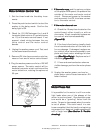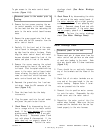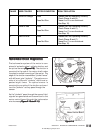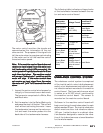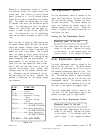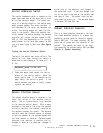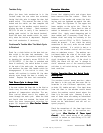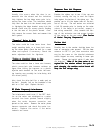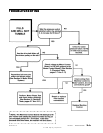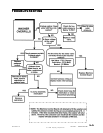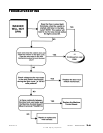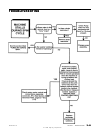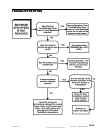
© 1998 Maytag Corporation
16008373-01 SECTION 3. TROUBLESHOOTING
3-23-2
3-23-2
3-2
Excessive Vibration:Excessive Vibration:
Excessive Vibration:Excessive Vibration:
Excessive Vibration:
Ensure that shipping bolts and straps have
been removed from the washer. Check the
levelness of the washer and ensure the level-
ing leg nuts are tightened up against the cabi-
net. Check the tightness of the upper and
lower weights on the outer tub. Check for
loose cabinet screws. Place hand on side of
cabinet to determine if vibration noise due to
cabinet flex. Apply sound dampening pad to
inner cabinet wall if necessary. Check the un-
balance circuit and wiring for continuity at the
machine control (P2(4) to P3(1). Continuity
should be present. If not, check the wiring
connections at the strut, outer tub and interial
unbalance switches. If a switch is bad or a
wire off, the machine control will not know
when an unbalance occurs. The machine con-
trol board checks the state of the circuit prior
to beginning the spin cycle, then monitors the
circuit throughout the cycle. If the circuit is
OPEN, the board will not see “a change in
state” whenever one of the normally-closed
switches is activated during an unbalanced
load condition.
Machine Operation Does Not Match CycleMachine Operation Does Not Match Cycle
Machine Operation Does Not Match CycleMachine Operation Does Not Match Cycle
Machine Operation Does Not Match Cycle
Description:Description:
Description:Description:
Description:
The machine control board monitors where
the timer is in the cycle and then uses this in-
formation to start different operations, such
as drain, fill, tumble and spin. Four input wires
from the timer to the machine control board
inform the machine control board where the
timer is in the wash cycle. However, if one or
more of these wires are making an intermittant
contact with the machine control board, the
board can be “misinformed” and will not re-
spond properly.
Check the connections of the timer input wires
leading from the timer to the machine con-
trol board
(See Section 2: Timer Input(See Section 2: Timer Input
(See Section 2: Timer Input(See Section 2: Timer Input
(See Section 2: Timer Input
Charts). Charts).
Charts). Charts).
Charts). Also, check wiring of all console
switches to ensure no cross-wiring of 24 VDC
and 120 VAC circuits.
Tumbles Only:
When the door lock mechanism is in the
"locked" mode, the wax motor has extended,
forcing the latch axle to engage the door lock
enable switch. This ensures the door is fully
locked and the switch can then complete the
signal back to the machine control board in-
dicating the door is locked. Check connector
P3(7)/YL 36 wire to verify if the terminal is
making good contact to the board terminal.
Check the door lock enable switch for conti-
nuity when the button is depressed. Replace
door lock mechanism if necessary.
ContinuesTo Tumble After The Wash Cycle
Is Finished:
Check for a stuck button on the door lock en-
able switch in the door lock mechanism. You
can verify this at the machine control board
by checking for continuity across P3(7)/YL 36
to P3(1)/RD23. If the door is unlocked and
there is continuity, the switch button is stuck.
At the end of the wash cycle, the machine con-
trol monitors the door lock enable switch for
disengagement. If the switch is stuck, the
washer will continue to tumble till the door
unlocks, even though the door is actually un-
locked. Replace the door lock mechanism.
Third Rinse Cycle Is Always Cold:Third Rinse Cycle Is Always Cold:
Third Rinse Cycle Is Always Cold:Third Rinse Cycle Is Always Cold:
Third Rinse Cycle Is Always Cold:
If the user rotates the timer dial to the third or
fourth rinse, the water will always be cold re-
gardless of temperature selection. The ma-
chine control board counts the number of
rinses through the wash cycle. When the third
and fourth rinse are reached, the board will
check the rinse temperature selection for
proper fill temperature
(See Section 1:Water (See Section 1:Water
(See Section 1:Water (See Section 1:Water
(See Section 1:Water
Temperature Inputs).Temperature Inputs).
Temperature Inputs).Temperature Inputs).
Temperature Inputs).



